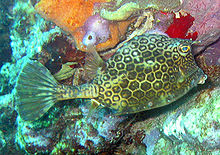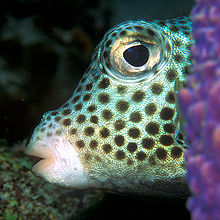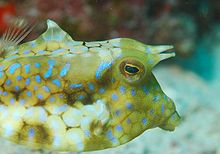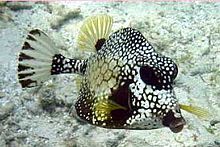- Ostraciidae
-
Boxfishes and trunkfish 
Honeycomb cowfish, Acanthostracion polygonius. Scientific classification Kingdom: Animalia Phylum: Chordata Class: Actinopterygii Order: Tetraodontiformes Family: Ostraciidae Genera 6 extant See text.
Ostraciidae is a family of squared, bony fish belonging to the order Tetraodontiformes, closely related to the pufferfishes and filefishes. Fish in the family are known variously as boxfishes, cofferfishes, cowfishes and trunkfishes. It contains 25 species in six extant genera.
Ostraciidae occupy the Atlantic, Indian, and Pacific oceans, generally at middle latitudes, although the common or buffalo trunkfish (Lactophrys trigonus) which lives mainly in Florida waters may be found as far north as Cape Cod. The cowfish variety Lactophrys quadricornis can grow to be 50 cm or less in size, but are generally smaller at higher latitudes.
They come in a variety of different colors, and are notable for the hexagonal or "honeycomb" patterns in their skin. They swim in a rowing manner. The hexagonal plate-like scales of these fish are fused together into a solid, triangular, box-like carapace, from which the fins, tail, eyes and mouth protrude. Because of these heavy armoured scales, Ostraciidae are limited to slow movements, but few other fish are able to eat the adults. Ostraciidae of the Genus Lactophrys also secrete poisons from their skin into the surrounding water, further protecting them from predation.[1] Although the adults are in general quite square in shape, young Ostraciidae are more rounded. The young often also exhibit brighter colors.
Classification
Family OSTRACIIDAE
- Genus †Eolactoria
- †Eolactoria sorbinii Tyler 1976 (Lutetian of Monte Bolca, Eocene Italy)
- Genus †Oligolactoria
- †Oligolactoria bubiki Tyler 1980 (Rupelian of Moravia, Oligocene Czech Republic)
- Genus Acanthostracion
- Acanthostracion guineensis (Bleeker, 1865).
- Island cowfish, Acanthostracion notacanthus (Bleeker, 1863).
- Honeycomb cowfish, Acanthostracion polygonius Poey, 1876.
- Scrawled cowfish, Acanthostracion quadricornis (Linnaeus, 1758).
- Genus Lactophrys
- Spotted trunkfish, Lactophrys bicaudalis (Linnaeus, 1758).
- Buffalo trunkfish, Lactophrys trigonus (Linnaeus, 1758).
- Smooth trunkfish, Lactophrys triqueter (Linnaeus, 1758).
- Genus Lactoria
- Longhorn cowfish, Lactoria cornuta (Linnaeus, 1758).
- Roundbelly cowfish, Lactoria diaphana (Bloch & Schneider, 1801).
- Thornback cowfish, Lactoria fornasini (Bianconi, 1846).
- Lactoria paschae (Rendahl, 1921).
- Genus Ostracion
- Yellow boxfish, Ostracion cubicus Linnaeus, 1758.
- Bluetail trunkfish, Ostracion cyanurus Rüppell, 1828.
- Ostracion immaculatus Temminck & Schlegel, 1850.
- Whitespotted boxfish, Ostracion meleagris Shaw, 1796.
- Shortnose boxfish, Ostracion nasus Bloch, 1785.
- Horn-nosed boxfish, Ostracion rhinorhynchos Bleeker, 1852.
- Reticulate boxfish, Ostracion solorensis Bleeker, 1853.
- Roughskin trunkfish, Ostracion trachys Randall, 1975.
- Whitley's box, Ostracion whitleyi Fowler, 1931.
- Genus Paracanthostracion
- Paracanthostracion lindsayi (Phillipps, 1932).
- Genus Tetrosomus
Toxic Defences
The various members of this family are able to secrete cationic surfactants through their skin which can act as a chemical defense mechanism. [2]. An example of this is pahutoxin, a water soluble, crystalline chemical toxin that is contained in mucus secreted from the skin of Ostracion lentiginosus and other members of the trunkfish family when they are under stress. [3]. Pahutoxin is a choline chloride ester of 3-acetoxypalmitic acid [1] that behaves similarly to steroidal saponins found in echinoderms. [4]. When this toxic mucus is released from the fish, it quickly dissolves in the environment and negatively affects any fish in the surrounding area. It is possible since this toxin resembles certain detergents so closely, that adding these detergents as pollutants to seawater has potential to interfere with receptor-mediated processes in marine life. [5].
References
- ^ Matsura, Keiichi & Tyler, James C. (1998). Paxton, J.R. & Eschmeyer, W.N.. ed. Encyclopedia of Fishes. San Diego: Academic Press. pp. 229–230. ISBN 0-12-547665-5.
- ^ Abdulhaqq, A.J. and Shier, W.T. (1991) Icthyocrinotoxins and their potential use as shark repellents. Journal of Toxicology-Toxin Reviews, 10(3): 289-320
- ^ Boylan, D. B. and Scheuer, P. J. (1967) Pahutoxin: A Fish Poison. American Association for the Advancement of Science, 155(3758): 52-56
- ^ Boylan, D. B. and Scheuer, P. J. (1967) Pahutoxin: A Fish Poison. American Association for the Advancement of Science, 155(3758): 52-56
- ^ Kalmanzon, E., Aknin-Herrman, R., Rahamim, Y., Carmeli, S., Barenholz, Y. and Zlotkin, E. (2001) Cooperative cocktail in a chemical defence mechanism of a trunkfish. Cellular & Molecular Biology Letters, 6: 971-984
- Froese, Rainer, and Daniel Pauly, eds. (2005). "Ostraciidae" in FishBase. November 2005 version.
- Zim, Herbert, and Shomemaker, Hurst. Fishes. Golden Press, New York (1955).
Categories: - Genus †Eolactoria
Wikimedia Foundation. 2010.



